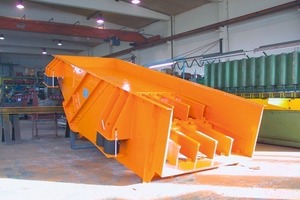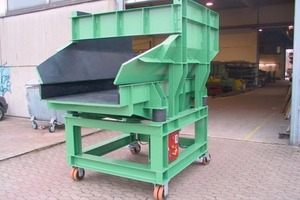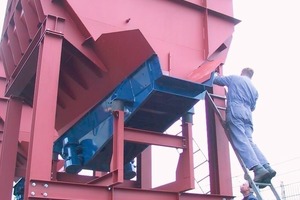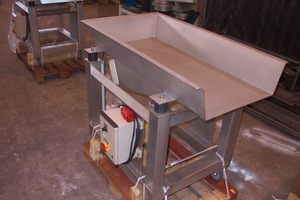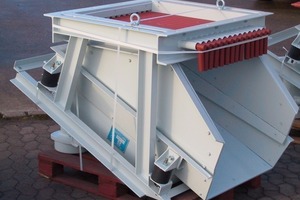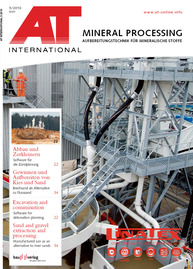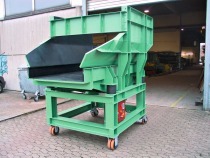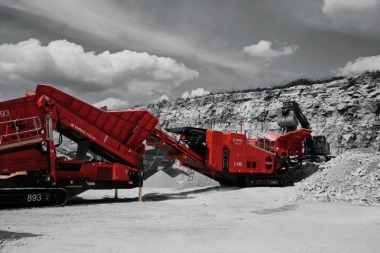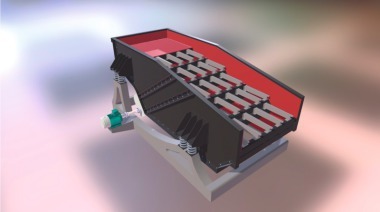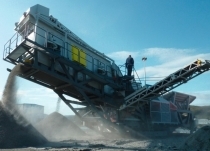Vibration for clean conveying
DOSIERTECHNIK GMBH® is a company founded in Münsterland (NRW/Germany) in 1962 that designs and manufactures conveyors, incorporating state-of-the-art manufacturing technologies for conveying, screening (Fig. 1) and feeding. The product range for drives comprises vibration motors, magnetic drives, unbalance exciters and shaft drives. DOSIERTECHNIK GMBH® integrates machines in existing plants and also develops individual special-purpose machines, maximum quality and optimum reliability being a declared corporate aim. The following report concerns the design, principle of operation and possible applications of vibratory conveyors.
Vibratory conveyors are machines that use vibration to transport materials and bulk solids. They are used for the clean discharge of materials from silos, for feeding belt conveyors, spiral conveyors, bucket conveyors, jaw crushers, impact mills, weighers, screens, dewatering screens, packaging machines, production lines, magnetic separators, trommel screens and centrifugal crushers, etc. Other names for vibratory conveyors include: magnetic feeders, unbalance feeders, conveyor feeders, feeders, tubular conveyors, unbalance vibrating conveyors, vibrating conveyors, vibrating tube conveyors, vibrating feeders, vibrating machines, distributor feeders, magnetic vibrating conveyors, mill feeders (Fig. 2), kiln feeders, crusher feeders, shaker conveyors, silo discharge feeders (Fig. 3), crusher discharge machines, spring-guided vibratory conveyors, linear-vibrating feeders, drying feeders, cooling feeders, cooling vibrating conveyors, sand cooling feeders, distributing shaker conveyors, vibrating conveyor dryers, magnetic vibratory conveyors, shaker chutes, spring-guided vibratory conveyors. The term vibratory conveyor, however, has become largely established as vibrations are used to assist conveying and this name is the most appropriate for describing the function of this machine.
Basically, vibratory conveyors can be used to transport all granular, lumpy and non-sticky materials that are dry and not prone to caking or sticking. Generally, bulk solids with a size range from 0.5 mm to 1200 mm can be easily conveyed and fed with these units. Vibratory conveyors are used in environmental engineering, e. g. in glass processing/recycling, in the timber industry, in waste recycling, waste processing and scrap recycling.
In the primary industries, vibratory conveyors are used for transporting construction site waste, in mining, in ore beneficiation, in the non-metallic minerals industry as well as the cement, lime and gypsum industries. In the processing industries, the machines are used in the chemicals, fertilizer, animal feed, plastics and foodstuffs industries. Other applications for vibratory conveyors are in the foundry and metallurgical industries. There they are used in foundries of all types, smelting works, small-scale iron working, dross processing, surface engineering and steel mills.
Essentially, there are two types of vibratory conveyors:
1. Vibratory conveyors with unbalance drive
2. Vibratory conveyors with magnetic drive
Vibratory conveyors with unbalance drive are used in applications where either no control or control between 30 % and 100 % of the capacity is required. This capacity range can be steplessly controlled with frequency controllers.
Vibratory conveyors with unbalance drives are sub-divided into different categories:
• Open conveyors (UR1, UR2, URS)
• Closed conveyors (URG1, URG2)
• Tubular conveyors URO1, URO2)
The design of the three categories can be customized to each application. For that reason there are short and long designs as well as open and closed models. Vibratory conveyors with unbalance drive can be generally built to a length of max. 6500 mm.
Vibratory conveyors with magnetic drive have a capacity range of 0-100 %. This stepless feeding capacity can also be regulated in coarse-fine flow operation. Additionally, this capacity can be regulated by an external signal of 0-20 mA, 4-20 mA und 0-10 V. Vibratory feeders with magnetic drive are controlled exclusively with DOSVIB regulators. The magnetic drive ensures that no material can run on after feeding is complete. This is a great benefit compared to unbalance drives, especially when controlled feeding material must be ensured.
Because of the vibrations, the maximum length of magnetic vibratory conveyors is 2500 mm. These short distances are ideal for feeding and control areas. Unbalance vibratory conveyors have proven effective for any further transport.
Magnetic conveyors are also divided into two categories:
• Open conveyors (VRF) (Fig. 4)
• Closed conveyors (VRG)
• Tubular conveyors (VRO)
Both types of vibratory feeder can also be installed as short designs under silos with a feeder shoe (Fig. 5). Feeder shoes are closing elements installed at silo discharges. These components, made of high-strength steel, can be equipped with emergency shut-off slides or needle-type slides for handling coarse material sizes. Only in emergencies do these slides serve to block the silo outlet (for example when the vibratory conveyor is dismantled when the silo is full).
Feeder shoes are installed beneath silo outlets. They take up the vibratory conveyor positioned below with the help of an integrated substructure. All baffles for guiding bulk materials are part of the feeder shoe. Therefore, the vibratory conveyor is moveable, freely adjustable and accessible. Feeder shoes are available as series models for all open vibratory conveyors up to 2 000 mm. The feeder shoes with emergency shut-off slides are divided into models for magnetic drives (AS-VRF) and for unbalance drives (AS-UR1).
Dosiertechnik GmbH, Greven/Germany,
Tel.: +49 2571 57705-0, www.dosiertechnik.com

